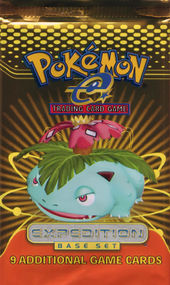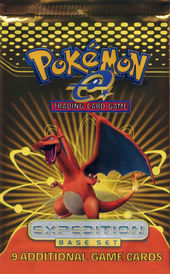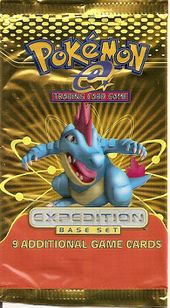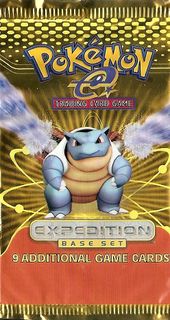Expedition Base Set (TCG): Difference between revisions
mNo edit summary |
|||
| Line 42: | Line 42: | ||
Expedition also introduced an updated card design, which included numerous changes. Firstly, the cards incorporate the Dot Code technology for use with the Nintendo [[e-Reader]]. By using the device, players were able to view Pokédex data about the Pokémon, play a minigame, play various tunes in a [[Construction: Melody Box|Melody Box]], or activate a [[List of TCG cards with hidden attacks|special attack]] for that Pokémon. However, these special attacks were not legal for use in tournament play as few competitors used e-Readers. As well as this, in events by [[Pokémon Organized Play]], electronic devices such as the e-Reader are not allowed on the table. Due to this feature, the left and bottom borders had been increased in size. The card also lacked the Pokémon's species, length, weight, Pokédex entries, and level (Non Holofoil Rare prints contained them), which were stored in the dot code. The illustrator and copyright information swapped position, and the set symbol is moved to the right side of the card number and rarity. Each card has an unique ID number in order for the e-Reader to distinguish each card with the same name in a way other than by level, which is located below the artwork. | Expedition also introduced an updated card design, which included numerous changes. Firstly, the cards incorporate the Dot Code technology for use with the Nintendo [[e-Reader]]. By using the device, players were able to view Pokédex data about the Pokémon, play a minigame, play various tunes in a [[Construction: Melody Box|Melody Box]], or activate a [[List of TCG cards with hidden attacks|special attack]] for that Pokémon. However, these special attacks were not legal for use in tournament play as few competitors used e-Readers. As well as this, in events by [[Pokémon Organized Play]], electronic devices such as the e-Reader are not allowed on the table. Due to this feature, the left and bottom borders had been increased in size. The card also lacked the Pokémon's species, length, weight, Pokédex entries, and level (Non Holofoil Rare prints contained them), which were stored in the dot code. The illustrator and copyright information swapped position, and the set symbol is moved to the right side of the card number and rarity. Each card has an unique ID number in order for the e-Reader to distinguish each card with the same name in a way other than by level, which is located below the artwork. | ||
Expedition once again featured Reverse | Expedition once again featured Reverse-holofoil cards, but the design was changed from the "wheel" treatment (which was reminiscent of European fake holofoil designs) to a plain "refractor" design. They are more "official" looking than the ones found in {{TCG|Legendary Collection}}. One problem brought to Wizard's attention was that both the holofoil and non-holofoil rare cards had identical reverse-holofoil counterparts (apart from the card number). Wizards rectified this in Aquapolis by numbering the holofoil cards differently and not producing reverse-holofoil for them. | ||
Because of the extra licensing fees Wizards had to pay to use the Dot Code technology, the booster pack size was reduced from 11 to 9. Each booster pack contained 5 Common cards, 2 Uncommon cards, 1 Reverse Holofoil card, and 1 Rare or Rare Holo card. | Because of the extra licensing fees Wizards had to pay to use the Dot Code technology, the booster pack size was reduced from 11 to 9. Each booster pack contained 5 Common cards, 2 Uncommon cards, 1 Reverse Holofoil card, and 1 Rare or Rare Holo card. | ||
| Line 358: | Line 358: | ||
|background=e7e66e | |background=e7e66e | ||
|border=ff6600 | |border=ff6600 | ||
|image1= | |image1=Expedition box.jpg | ||
|caption1=English | |caption1=English Booster Box | ||
|image2=E1 Booster Venusaur.jpg | |image2=E1 Booster Venusaur.jpg | ||
|caption2=English Venusaur Pack | |caption2=English Venusaur Pack | ||
|image3=E1 Booster | |image3=E1 Booster Charizard.jpg | ||
|caption3=English | |caption3=English Charizard Pack | ||
| | |image5=E1 Booster Feraligatr.jpg | ||
| | |caption5=English Feraligatr Pack | ||
| | |image6=E1 Booster Blastoise.jpg | ||
| | |caption6=English Blastoise Pack | ||
| | |image7=E1 Base Set - Booster Pack front.jpg | ||
| | |caption7=Japanese Pack | ||
}} | }} | ||
Revision as of 04:51, 9 July 2020
- "EX" redirects here. For the classifications of Pokémon cards, see Pokémon-ex (TCG) and Pokémon-EX (TCG). For TCG expansions in the EX Series, see the List of Pokémon Trading Card Game expansions. For the stages in Pokémon Shuffle abbreviated as "EX", see Expert Stages.
|
|
|
| |||||||||||||||||
| |||||||||||||||||
Expedition Base Set (Japanese: 基本拡張パック Base Expansion Pack) is the name given to the first main expansion of cards from the e-Card Series of the Pokémon Trading Card Game (the e-Card Era in Japan). The set is the first to be compatible with Nintendo's e-Reader peripheral in the card game.
Description
More electrifying than ever!
The Pokémon® trading card game is going where no trading card game has ever gone before—the Game Boy Advance™. The Pokémon-e: Expedition™ base set has new attacks, new game effects, new Pokémon Powers (now called Poké-Powers and Poké-Bodies), new Trainer cards, and even a ool new card design. And now you can swipe your cards through a Nintendo® e-Reader to play fun video games on Game Boy Advance!
Play Expedition, and you could be in for a shock!
Information
Expedition Base Set is the name given to the first main expansion of the e-Card Series of the Pokémon Trading Card Game. In Japan, it was released as Base Expansion Pack, the first expansion in the Pokémon Card Game e-Card Era. The English expansion was released on September 15, 2002, while the Japanese expansion was released on December 1, 2001. It was originally printed for release in May 2002; however, it was delayed until August to ensure the e-Reader was released before the expansion. Further issues delayed it again until September. It was further delayed in Europe in order for the e-Reader to be released before it; however, the e-Reader did not see release in Europe, and the expansion was eventually released in April 2003.
Expedition introduced Poké-Powers and Poké-Bodies, previously known as Pokémon Power. Poké-Powers required activation to use, whereas Poké-Bodies were always active unless blocked by a specific effect.
Expedition also introduced an updated card design, which included numerous changes. Firstly, the cards incorporate the Dot Code technology for use with the Nintendo e-Reader. By using the device, players were able to view Pokédex data about the Pokémon, play a minigame, play various tunes in a Melody Box, or activate a special attack for that Pokémon. However, these special attacks were not legal for use in tournament play as few competitors used e-Readers. As well as this, in events by Pokémon Organized Play, electronic devices such as the e-Reader are not allowed on the table. Due to this feature, the left and bottom borders had been increased in size. The card also lacked the Pokémon's species, length, weight, Pokédex entries, and level (Non Holofoil Rare prints contained them), which were stored in the dot code. The illustrator and copyright information swapped position, and the set symbol is moved to the right side of the card number and rarity. Each card has an unique ID number in order for the e-Reader to distinguish each card with the same name in a way other than by level, which is located below the artwork.
Expedition once again featured Reverse-holofoil cards, but the design was changed from the "wheel" treatment (which was reminiscent of European fake holofoil designs) to a plain "refractor" design. They are more "official" looking than the ones found in Legendary Collection. One problem brought to Wizard's attention was that both the holofoil and non-holofoil rare cards had identical reverse-holofoil counterparts (apart from the card number). Wizards rectified this in Aquapolis by numbering the holofoil cards differently and not producing reverse-holofoil for them.
Because of the extra licensing fees Wizards had to pay to use the Dot Code technology, the booster pack size was reduced from 11 to 9. Each booster pack contained 5 Common cards, 2 Uncommon cards, 1 Reverse Holofoil card, and 1 Rare or Rare Holo card.
| ||||||||||||||||||||
| ||||||||||||||||||||
Set lists
|
| ||||||||||||||||||||||||||||||||||||||||||||||||||||||||||||||||||||||||||||||||||||||||||||||||||||||||||||||||||||||||||||||||||||||||||||||||||||||||||||||||||||||||||||||||||||||||||||||||||||||||||||||||||||||||||||||||||||||||||||||||||||||||||||||||||||||||||||||||||||||||||||||||||||||||||||||||||||||||||||||||||||||||||||||||||||||||||||||||||||||||||||||||||||||||||||||||||||||||||||||||||||||||||||||||||||||||||||||||||||||||||||||||||||||||||||||||||||||||||||||||||||||||||||||||||||||||||||||||||||||||||||||||||||||||||||||||||||||||||||||||||||||||||||||||||||||||||||||||||||||||||||||||||||||||||||||||||||||||||||||||||||||||||||||||||||||||||||||||||||||||||||||||||||||||||||||||||||||||||||||||||||||||||||||||||||||||||||||||||||||||||||||||||||||||||||||||||||||||||||||||||||||||||||||||||||||||||||||||||||||||||||||||||||||||||||||||||||||||||||||||||||||||||||||||||||||||||||||||||||||||||||||||||||||||||||||||||||||||||||||||||||||||||||||||||||||||||||||||||||||
Pack artwork
|
|
|
||||||
|
|
|
In other languages
| |||||||||||||||

|
This article is part of Project TCG, a Bulbapedia project that aims to report on every aspect of the Pokémon Trading Card Game. |
| Pokémon Trading Card Game expansions and releases Bold indicates a main expansion. Italics indicate a special set. Releases that are entirely composed of prints from other releases are small. | |||
|---|---|---|---|
|
|||




